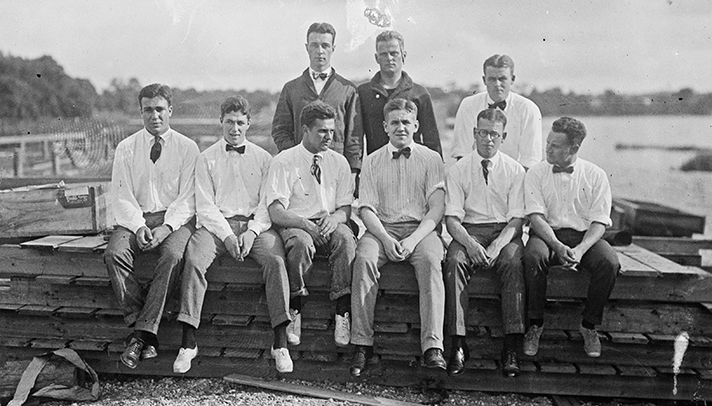
In the summer of 1916, 12 Yale students came to Port Washington to learn how to fly. They were mostly jocks, children of the privileged class, motivated by the lure of an exciting new industry and a patriotic desire to serve their country. They called themselves the First Yale Unit.
The aviation school where they trained was just north of the Port Washington Yacht Club. It was the brainchild of retailer Rodman Wannamaker, who had founded the American Trans-Ocean Company with the intention of providing the first passenger service from New York to Paris. Although the outbreak of WW1 in Europe thwarted those plans, it did not diminish his wish to be a player in the aeronautics industry.
He reset his sights on establishing a training center for aspiring pilots. Early in 1916 he identified Manhasset Bay with its protected waters and proximity to New York City as the ideal location for an aviation school. He contracted with the Curtiss Aeroplane Company to manage the new training center that would be the largest of its kind in the world.
At the same time in New Haven, Yale student Trubee Davidson had an idea to recruit fellow students to train as pilots in the patriotic spirit of “preparedness” for entrance into the war that was raging in Europe. He wanted a unit of 12 that could be divided into four teams of three who would all be cross-trained in the roles of pilot, observer, and anti-aircraft gun operator.
His father, Henry Pomeroy Davidson, a senior partner of J.P. Morgan & Co, used his influence to obtain a meeting for his son in Washington, D.C., to present his idea to the secretary of the Navy. Not convinced of the value of seaplanes for coastal defense, the Navy turned him down.
His parents, on the other hand, were believers. His father agreed to finance the project and contracted with the Wannamaker school to provide training. He purchased an airplane, the “Mary Anne,” to get them started. Later that summer, Daniel Pomeroy and Mrs. Davidson contributed two more.
Mrs. Davidson was the hands-on champion. She provided room and board for the aspiring pilots at her estate, Peacock Point, in Lattington, 13 miles from Port Washington. She convinced other mothers that flying was safe, taking a ride herself in the “Mary Anne” to prove her point. To offset the public perception that this was a Millionaire’s Club, she told The New York Times, “For these boys, flying is not a sport. It is real earnest work to make them fit for service to their country.”
One of the volunteers, Wells Brown, recalled that “Mrs. Davidson was kind enough to prepare our breakfast the night before…We used to bounce out of bed just as dawn was breaking and run to a window to look at the Sound. If we could see the Connecticut shore, we jumped into our clothes and swallowed breakfast and then had a wild ride to Port Washington with Bob Lovett. This was by all odds the most dangerous thing we did that summer.”
The lead instructor, David McCullogh, was well known in Port Washington, and had a reputation as a free spirit. He was one of the first pilots to fly over Manhasset Bay a few years earlier. To understand the nation’s fascination with flying, just imagine how thrilling and uncanny it was lto see a boat with wings rise up from the water and float in the sky for the first time.
The wannabe pilots were anxious to get started, but McCullogh was set on disabusing them of any romantic notions about flying, reminding them that “a dead pilot is no good to anyone.” His first order of business was to train them as mechanics who could overhaul and repair sea planes, and for better or worse, “Mary Anne” was very much in need of repair.
In September, the Navy invited them to participate in a training maneuver at Gravesend Bay in Brooklyn in which their first task was to identify underwater mines from the air, and the second was to find two destroyers masquerading as hostile cruisers. With McCullogh as pilot and Trubee as observer, they met the challenge, leading the Navy to acknowledge that “aeronautics has been shamefully neglected.”
Now fully embraced by the Navy, they resumed training on winter vacation in Florida and returned to Long Island the following summer to complete their training, this time at Huntington Bay. Their unit would ultimately train 29 pilots to serve in WW1 as the First Naval Aviation Unit – surveying enemy troop movements, chasing U-boats and zeppelins, and engaging enemy planes over Europe.
Many prominent figures emerged from this small group of pilots following the war. Most relevant for our local history was Juan Trippe, the entrepreneur who founded Pan American Airlines. In the 30s, Pan Am took over an abandoned air terminal on Manhasset Isle, and made Wannamaker’s dream of a trans-Atlantic passenger service to Paris a reality in 1939.
Ross Lumpkin is a trustee at the Cow Neck Peninsula Historical Society, www.cowneck.org






